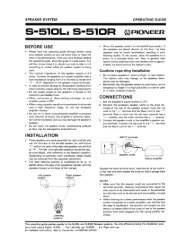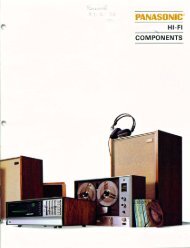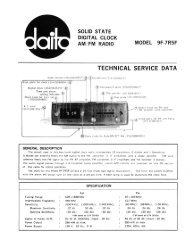Zenith HF-46 Stereo Receivers Models MC7031, MC7041, MC7051 ...
Zenith HF-46 Stereo Receivers Models MC7031, MC7041, MC7051 ...
Zenith HF-46 Stereo Receivers Models MC7031, MC7041, MC7051 ...
Create successful ePaper yourself
Turn your PDF publications into a flip-book with our unique Google optimized e-Paper software.
AM/FM/MULTIPLEX ALIGNMENT<br />
GENERAL<br />
These receivers have been aligned at the factory and normally<br />
will not require further adjustment. As a result, it is not<br />
recommended that any attempt be made to alter the stages.<br />
If any components are replaced or if anyone tampers with<br />
the adjustments, realignment may be necessary.<br />
AM ALIGNMENT<br />
It is recommended that AM IF's be aligned by the sweep<br />
method shown in the alignment procedure on the following<br />
pages. If your signal generator does not have sweep capabilities<br />
for the AM IF, use the alternate alignment procedure shown.<br />
FM ALIGNMENT<br />
Because of the wide band pass required in a FM Multiplex<br />
tuner, it is desirable to use an FM signal generator having a<br />
deviation of 250kHz as well as an oscilloscope, when aligning<br />
both the FM IF and RF portions of this receiver. It is not only<br />
necessary to obtain maximum amplitude in the IF amplifier<br />
stages, but also necessary to maintain symmetry. It is desirable<br />
to use markers in obtaining IF curve symmetry.<br />
Capacitors mentioned in the alignment procedure should be as<br />
small in size as possible and the ground lead of the generator<br />
must be connected to ground as close as possible to the point<br />
of injection.<br />
MULTIPLEX ALIGNMENT<br />
Before any attempt is made to align, or service, FM Multiplex<br />
circuitry, the technician must be certain that the RF, IF, and<br />
Detector alignment is correct, and that the receiver functions<br />
normally on monaural signals.<br />
Most Multiplex generators are excellent troubleshooting devices<br />
because they provide a composite Multiplex signal as well<br />
as an RF signal (which is FM modulated by the composite<br />
multiplex signal). The composite signal is very useful since it<br />
can be used in signal tracing the Multiplex portion of the<br />
receiver. We do not recommend that Multiplex alignment be<br />
made using the composite signal injected at the output terminal<br />
of the Detector since there is alway some phase shift<br />
occurring in the RF, IF or Detector circuits. As a result,<br />
Multiplex alignment made by a signal injected at the Detector<br />
input would not be correct. For proper Multiplex alignment,<br />
the composite signal must FM modulate the RF carrier and<br />
then be fed into the FM antenna terminals. With the signal<br />
injected in this manner, the Multiplex alignment would then<br />
be the best that could possibly be obtained.<br />
RF signals should be injected at a point in the FM band where<br />
no signal is present. If at all possible, this should be at a<br />
frequency near the middle of the FM band. Tune the FM<br />
receiver to this point and adjust the RF frequency adjustment<br />
on the generator to this same frequency. The AGC voltage<br />
developed in the receiver should be maximum. The AGC<br />
voltage substantially less than this may indicate the RF<br />
frequency is tuned to an image.<br />
GENERAL TROUBLE-SHOOTING PROCEDURE<br />
Should a problem arise in aligning the FM Multiplex portion<br />
of the receiver, the technician must determine whether the<br />
difficulty lies in the RF, IF, and Detector portions of the<br />
receiver, or whether the difficulty lies in the Multiplex portion.<br />
The composite output of the multiplex generator can be<br />
injected at the output of the Detector to help determine the<br />
area of difficulty. To reduce possible extraneous signals<br />
coming through a Detector, short the Detector primary with a<br />
jumper lead. The wave forms and their magnitude may vary<br />
slightly from chassis to chassis, however, they are quite<br />
indicative of what will be seen when signal tracing the<br />
Multiplex circuitry.<br />
If all the waveforms are similar in form and magnitude to<br />
those indicated, it can be assumed that the Multiplex portion<br />
of the receiver is functioning properly and the problem lies<br />
ahead of this in the FM receiver. If any of the waveforms are<br />
missing at a latter point but are apparent at a previous point,<br />
circuitry between the two test points should be checked.<br />
SCOPE PATTERN "A "<br />
SCOPE PATTERN "B"<br />
PROBE "A" - RF INPUT PROBE "B"- DE-EMPHASIS PROBE "C"- DETECTOR PROBE<br />
11











